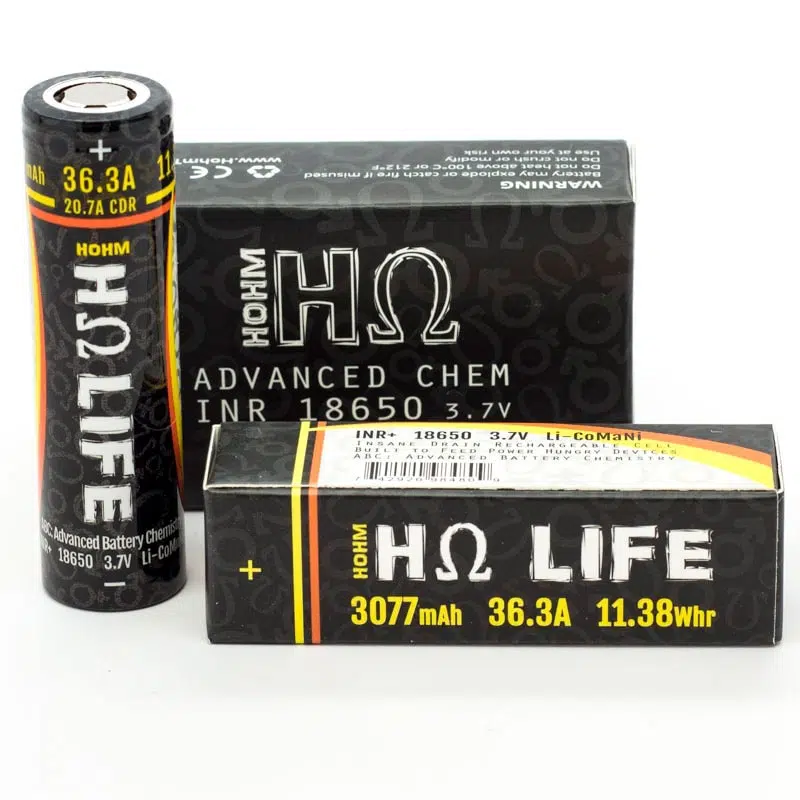Beginner Topics, Educational
Choosing the Right Battery
There are a lot of battery options out there. So, how do you know which ones are good, and which one is right for you? Well, today that’s exactly what we are going to dive into.
There is a Difference
The first thing to clear up is that there really is a difference between all those 18650’s out there. You really shouldn’t be using flashlight batteries, laptop batteries, or R/C car batteries. Yes, they are 18650’s, and yes they can power on your device. The problem comes when your mod asks for more power than the battery is designed to give. That battery will try it’s best; but then you run the risk of becoming a battery accident statistic.

So, what are the main things to look for in a good vape battery? There are some specific vape battery manufactures such as Hohm Tech, that create and market their batteries exclusively for vaping use. There are also widely used batteries that while their makers do not make them for the purpose of vaping, are widely used and generally considered safe. LG, Samsung, and Sony are some examples of those. If you are unsure of the technical aspect of milliamps, amps, and constant vs pulse rates, etc; then you can rely on your vape store staff to guide you in the right direction. Trust them more than what you read on some shady DIY page. I’ve seen people come in with mods that have been damaged by using the wrong kind of batteries. All to save four or five dollars.
Now for the Technical Part of our Discussion
Let’s go through the basics of terms used and their practical application one by one.
Milliamps per hour (MAH): This speaks to the overall capacity of the battery. To keep it simple for our purposes, let’s just say the higher the “MAH” the longer the battery will last between charges. Most vape batteries are going to be around 3000 MAH as of 2018. 3000 MAH can get most regulated devices through a half day at high wattage, and a whole day at lower wattages. So, I would highly recommend getting double the amount of batteries as your device holds. This way, you can switch out in the middle of the day if you need to.
The other thing to consider is the batteries constant amp rating. Again, to keep it simple, lets just think of amps as the power the battery can deliver. Not the charge of the battery; but it’s actual output potential so to speak. So, by way of example, a 20amp battery would obviously have less potential power than a 30amp battery. However, this doesn’t mean go get the highest amperage you can get your hands on (though more amps are safer). You only need what’s right for your device. This is where ohm’s law will be important to you mech users. However, for the purpose of most variable wattage mods with tanks using prepackaged coils, you will not generally need batteries with a rating of more than 20amps.
So, what’s the difference between pulse & constant amp rates?
Well, pulse rates are a bit misleading, and if I had my preference as a vape shop owner, I’d see them go away. Too many people have thought that if they build out of spec; but within the pulse rate, they would be ok. Unfortunately, this can go from dangerous, to thermal runaway in a hurry! The constant amp rate is really the true max for the battery as stated by the manufacture. Pulse rates get added when the batteries are wrapped by the third party selling them or by third party testing. Whilst the battery can achieve it, it is outside of the manufacture operating parameters. This can very quickly lead to what’s called a ‘Thermal Run-Away’. This means the batteries reaction is now self-sustaining, and it WILL vent.
If the pressure doesn’t have a good escape route though, it can cause a tank or RDA to fly off, or the mod to explode. So, the moral of the story is operate your device within the manufactures specs. That’s not really an issue with regulated devices, as long as it’s a battery accepted for vaping. However, if a mech user doesn’t understand ohm’s law, they can build too low of a sub ohm coil or coils on their deck, and boom.

I personally use Hohm Life’s, and those purple tear resistant eFest. Both seem to do really well in my VooPoo Drag, with a TFV8. When I was dripping more, I would use LG’s or Aspires a lot. Now, Hohm Life actually makes a mech specific battery called an Hohm Work. I’d probably give that a shot, as they seem to be super consistent well-made batteries. I still own a lot of the brown LG’s too; but I’d say my battery portfolio consists mostly of those eFest at this point.
In recap, pay no attention to pulse rate. What’s important is the constant rate a battery is made to output. MAH equals battery life, not power. Finally, stick with the main well-known brands, and preferably find a vape shop that does their due diligence to weed out any clones/re-wraps.
Battery Safety
When it comes to battery safety you should take it seriously. Most accidents could have been prevented by following three simple rules.
- If the wrap on your battery is torn, get it re-wrapped or re-wrap it yourself. The wraps are dirt cheap, and well worth your safety.
- If the top of the battery is torn exposing the insulator, DO NOT use it until the wrap is replaced. If that gap is bridged by your tank pin or any other conductive material, the battery will immediately dump everything it has into that area. So, if whatever is bridging it doesn’t burn off or move, the battery will vent within seconds.
- For those building coils, follow Ohm’s law. To make that easy, here is a chart:

That more or less sums up batteries for now. I hope you found this info helpful. Happy Vaping, and thanks for reading!


